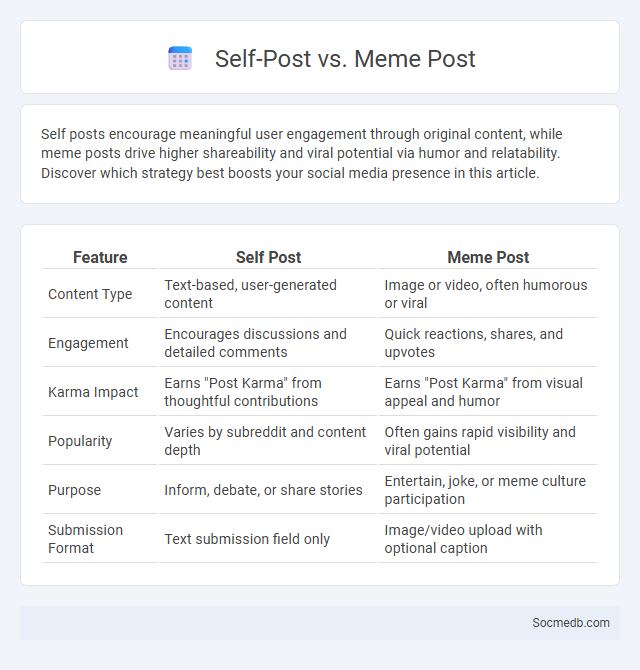
Photo illustration: Self Post vs Meme Post
Self posts encourage meaningful user engagement through original content, while meme posts drive higher shareability and viral potential via humor and relatability. Discover which strategy best boosts your social media presence in this article.
Table of Comparison
| Feature | Self Post | Meme Post |
|---|---|---|
| Content Type | Text-based, user-generated content | Image or video, often humorous or viral |
| Engagement | Encourages discussions and detailed comments | Quick reactions, shares, and upvotes |
| Karma Impact | Earns "Post Karma" from thoughtful contributions | Earns "Post Karma" from visual appeal and humor |
| Popularity | Varies by subreddit and content depth | Often gains rapid visibility and viral potential |
| Purpose | Inform, debate, or share stories | Entertain, joke, or meme culture participation |
| Submission Format | Text submission field only | Image/video upload with optional caption |
Understanding Self Posts: Definition and Purpose
Self posts, also known as text posts, are social media updates where users share personal thoughts, experiences, or questions without external links or media attachments, primarily on platforms like Reddit and Facebook. These posts encourage engagement through comments and discussions, fostering community interaction and support around shared interests or challenges. Their purpose is to promote authentic communication, build connections, and generate meaningful conversations within social networks.
What Is a Meme Post? Key Characteristics
A meme post is a piece of content, often humorous, that combines images, text, or videos to convey a specific idea or cultural reference quickly and engagingly. Key characteristics include relatability, simplicity, and shareability, enabling rapid spread across social media platforms such as Instagram, Twitter, and Facebook. Understanding these traits helps you create viral content that resonates deeply with your audience.
Self Post vs Meme Post: Fundamental Differences
Self posts on social media emphasize original, personal content that fosters direct engagement and deeper audience connection through authentic storytelling or sharing experiences. Meme posts leverage humor and viral potential by using relatable, easily shareable images or videos that often drive higher reach but lower personalized interaction. Understanding the fundamental difference lies in content purpose: self posts build community trust and loyalty, whereas meme posts prioritize rapid visibility and mass appeal.
Pros and Cons of Self Posts
Self posts on social media foster genuine engagement by encouraging users to share original content, which builds authentic connections and trust within communities. However, the lack of external links in self posts can limit content discoverability and reduce traffic to external websites, impacting overall reach. Balancing self posts with diverse content types optimizes interaction and maintains audience interest across platforms.
Pros and Cons of Meme Posts
Meme posts on social media boost engagement by capturing attention with humor and relatability, often increasing shares and brand visibility. However, meme content can sometimes backfire if it offends or alienates certain audiences, risking negative backlash and damage to reputation. Creators must balance timely, relevant humor with sensitivity to maintain positive user interaction and brand integrity.
Audience Engagement: Self Posts vs Meme Posts
Audience engagement on social media varies significantly between self posts and meme posts, with meme posts typically generating higher interaction rates due to their relatable and shareable nature. Self posts often foster deeper connections as they provide personal insights and storytelling, encouraging meaningful comments and discussions. Analyzing engagement metrics reveals that memes attract broader reach and quicker reactions, while self posts build loyal communities through sustained interaction.
Content Moderation: Handling Self and Meme Posts
Content moderation on social media platforms involves the strategic review and management of user-generated material, particularly self-posts and meme content which often blur the line between humor and offensive messaging. Algorithms and human moderators collaboratively assess context, intent, and community guidelines to mitigate misinformation, hate speech, and harassment while preserving creative expression. Effective content moderation enhances user safety and platform integrity by balancing free speech with regulatory compliance and ethical standards.
Community Preferences: Trends and Insights
Community preferences on social media reveal growing trends toward authentic engagement and niche content creation, with users favoring platforms that prioritize privacy and meaningful interactions. Insights show that YouTube, Instagram, and TikTok dominate in terms of user preference due to their algorithmic personalization and multimedia capabilities. Understanding these evolving preferences helps Your social media strategy align with audience expectations, boosting engagement and brand loyalty.
Effective Strategies for Posting Self and Meme Content
Posting self and meme content on social media requires a strategic balance of authenticity and humor to maximize engagement. Utilizing trending hashtags, peak posting times, and tailoring content to platform-specific audiences enhances visibility and interaction. Consistent posting schedules combined with relatable, high-quality memes and personal moments foster stronger community connections and brand loyalty.
Choosing the Right Post Type for Maximum Impact
Selecting the optimal post type on social media hinges on understanding your target audience's preferences and platform-specific algorithms. Visual content such as images and videos often generate higher engagement rates, with video content driving up to 1200% more shares than text-based posts. Leveraging interactive formats like polls, stories, and reels can maximize visibility and foster stronger connections, boosting brand awareness and user interaction.
 socmedb.com
socmedb.com